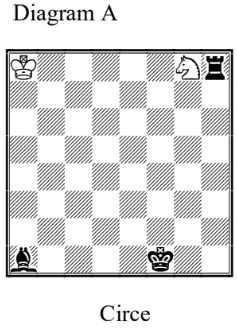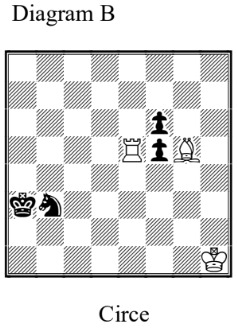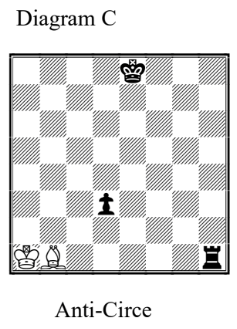
Unpin in JF10JT:
important clarification
We’re grateful to all of you for your comments and questions regarding pin/unpin definition for this tournament!
After some thoughts and discussions we decided to allow almost any interpretation of the given definition of a fairy unpin. We are not trying to produce the final definitions of pin and unpin here, we are running a tourney! Still, we would not like to call a normal un-paralysing move an unpin (in a problem using paralyzing pieces, or Madrasi, etc), and even less an ordinary line-opening… The same time we would allow the fairy concepts of self-unpin.
So, please see an update to previously given definition of unpin for this tournament:
Theme: Unpin of any kind. The unpinned piece may be white, black or neutral, and unpinning may be done by any side, in any way: interposition, withdrawal, K move, etc. For this tourney, we define a pin to be a situation where a random move by one piece would cause its own K to be in check from one or more enemy pieces = the pinner(s). An unpin is any move that eliminates this situation, including self-unpin (the pinned piece makes a move that eliminates the pin) but excluding captures of the pinned piece that remove it from the board.
This means that we now allow self-unpins where the pinned piece captures the pinner, and also allow captures of the pinned piece as long as it is reborn somewhere else on the board (so it is now unpinned).
The tourney may provide material for a future discussion about how best to define pin and unpin in the fairy field.
To give you a better idea here are three examples provided by Ricardo Vieira:

1.Bf6 Sxf6[Bf8] – thematic!
First, 1.Bf6 move may be treated as allowing Sg8 to move.
Second, 1…Sxf6[Bf8] move may be treated as self-unpin.

After Sa1 fxe5 is legal
After Sc1 fxg5 is legal
not thematic because random move by Pf6 won’t be self-check.

1.Bxd3[Bf1] not thematic, as opposed to the definition (doesn’t eliminate the situation of pin)
Welcome to participate! – Julia Vysotska (tournament director) & Kjell Widlert (judge)
Deadline: February 10th 2022
Please, send computer tested problems only (indicate the program used for testing), to julia@juliasfairies.com
Results and prize giving: May 15th 2022 in Riga, at the closing ceremony of the 15th ECSC.
Prize fund €450 : Three prizes in each section, each prize €50.
See Examples in the updated PDF announcement JF10JT (the version includes just published clarifications)

To Diagram C.
Is the following rendering (scheme) thematic? White bishop is immobile initially, but receives the legal move while stays pinned before and after it.
White : Ka1 Qb2 Bb1
Black : Kc4 Rh1 Na8 Pc5d5d4
h‡1 (3+6)
Anticircй
1.d3 Bxd3(Bf1)‡
It’s a Pelle move, not an unpin.
The question was: Is black d4-d3 unpin?
No, after d4-d3 move Bb1 remains to be pinned – couldn’t make a random move.
What if the unpin results in a selfpin on a different line?
W: Kh8, Bg8
B: Ra8, Rh1, Sh7
Thematic, IMO, since the original pin is eliminated. The TT definition doesn’t prohibit moves by the unpinned piece which are self-pins on a different line. If such a move was the final mating move, the self-pin would be irrelevant anyway.
True, it is thematic; the main thing is that Bg8 does the self-unpin from the line where it was initially pinned. Nobody cares if he got out of the frying pan into the fire 😉
Technically, the unpin/repin doesn’t eliminate the pinned status of the bishop, so if the definition is interpreted literally, the example isn’t an unpin.
By Kjell: “The example by Joost is a bit more unclear, but I agree with you again: the wB performs a self-unpin from the original pin-line but ends up in a new pin on a new pin-line. If you read our definition very literally (we wrote something about “now unpinned”) it would be unthematic, but the idea of a self-unpin is clearly there and I think we should be generous rather than strict. So I think we should accept this kind of self-unpin in this tournament.“
And I’m sorry for any possible confusions our definition still might have! You see, it is not so easy to include all possibilities. But we would gladly accept your fairy unpins of different kinds!
Here’s my contribution to the headaches of Kjell and Julia!
Is this thematic?
(Sorry! Read Rxd8 as Rxc8)
The rook isn’t pinned, as a random move doesn’t expose the king to check.
Oh, I hardly could find the pin here 🙂 and consulted with the judge.
Kjell’s reply is “it seems to me unthematic: a “random” move by the wR does not cause a self-check, only a particular move (Rxc8>h1). So this is far removed from our definition of an unpin.
How encouraging that so many people are interested in our theme!”
My previous two comments are approved by the judge too with the nice words that “we should be generous rather than strict”
If the WR was on c8, then it is pinned and black move Bg8 is an unpin. But of course that is a different well known situation ☺️
One more! 😉
Here, are both white moves thematic?
I see it as Rc8 is still pin, the same as Rc6.
frying pan = line a8-f3, fire = rebirth square c8. And back again, only this time, the WR ate the frying pan. 😉
Hm.. but may be more like Pelle move, as pinning line or pinning piece is the same? 😉
The pinning piece is the same.
But pinning effects are different:
Or it may be useful to consider that c8 belongs to the checking line. After all in Anti-Circe bishops don’t move on straight lines only (and capture like locusts).
If this approach is adopted (it’s not my invention, see e.g. http://www.jurajlorinc.com/chess/theo28tt.htm), then Rc8 is just a regular Pelle move.
Rc8 is Pelle move. Rxc6 is not unpin since it is capture of pinner which vanishes
The theme now explicitly allows the capture of the pinner by the pinned piece.
Yyou are right.
I am currently trying to create a reasonable definition of pin/unpin.
I need more time to prepare the text, but I can now produce the answers to the questions here according to proposed definition.
Correction to p.4. White second move is not unpin, but black Bc6 is.
Georgi, why is Bg8 not pinned? A random move of the bishop will result in self-check, only the specific move Bxh7[Sg8] is legal because it self-unpins.
It is pinned – see definition below in separate post.
The idea of unpin is not to move the pinned piece, but to _allow_ it to move. So, unpin is to happen _before_ the intended move of pinned piece.
The promised definition attempt.
The pin.
The piece is pinned if on its removal from the board the king of the side which has the right to make a move with this piece will appear attacked.
1. The pin is static. It is not required that pinned piece can move (e.g., W: Kg1, Bf1, Pe2g2 – B: Rc1: white bishop is pinned). Also, no arrival effects in case of the move are to be taken into account when checking for the pin.
2. The group of squares where the pinned piece can be repositioned keeping the pin intact including the square of the attacker of the king (pinner) is considered to be a pin line.
3. There are three kinds of pin.
a) Full pin. The pinned piece has no legal moves.
b) Partial pin. The pinned piece has legal move(s), but has to remain on the pin line.
c) Limited pin. The pinned piece has legal move(s) that allow it to leave the pin line.
The unpin.
The unpin is considered to happen in two cases.
1. The pin in above sense is destroyed, that is there will no longer be an attack on the king.
2. A situation of limited pin is created, expanded or changed.
The confirmation of unpin.
From artistic point of view one expects that unpinned piece will play during the solution, confirming that it is no longer pinned. Such move is not the unpin. Still it is expected that used opportunity to move away from pin line was created during previous play (the unpin happens at this moment). The only case there pinned piece may unpin itself is when it captures the pinner.
The masked, preliminary, anticipatory, etc. unpin
I see no way to strictly define these cases, as during the solution the pin itself may not appear at all. There may also be unobvious distinction between unpinning and avoiding the pin. So, these cases are to be left to the judge’s opinion anyway.
Should stop now!
https://en.wikipedia.org/wiki/How_many_angels_can_dance_on_the_head_of_a_pin
I recognise Julia! Who are the other two fairies? ??